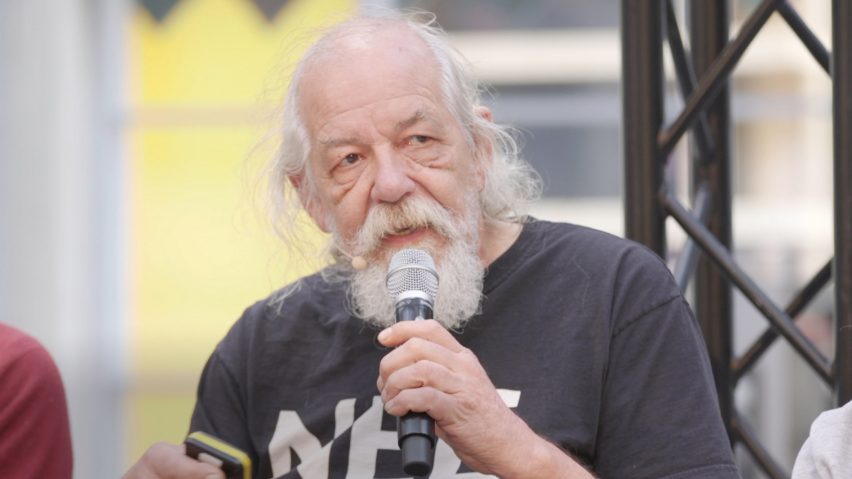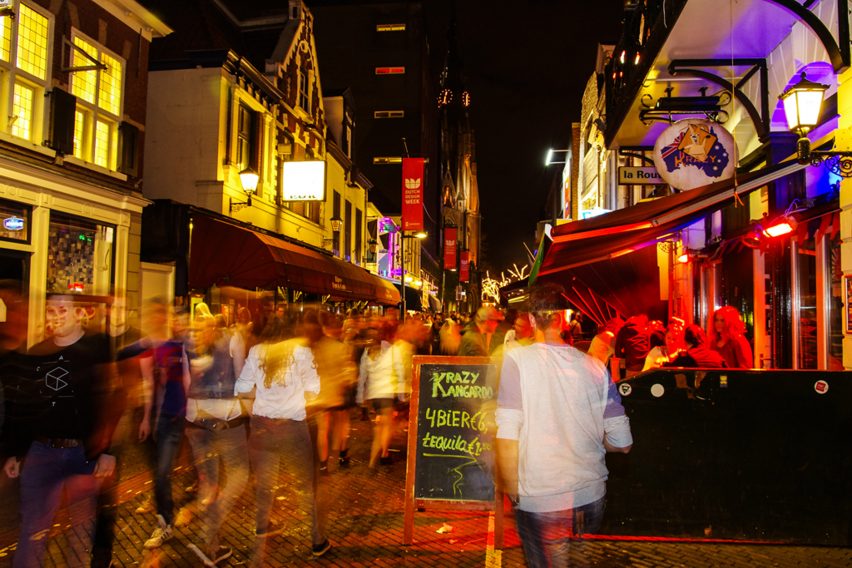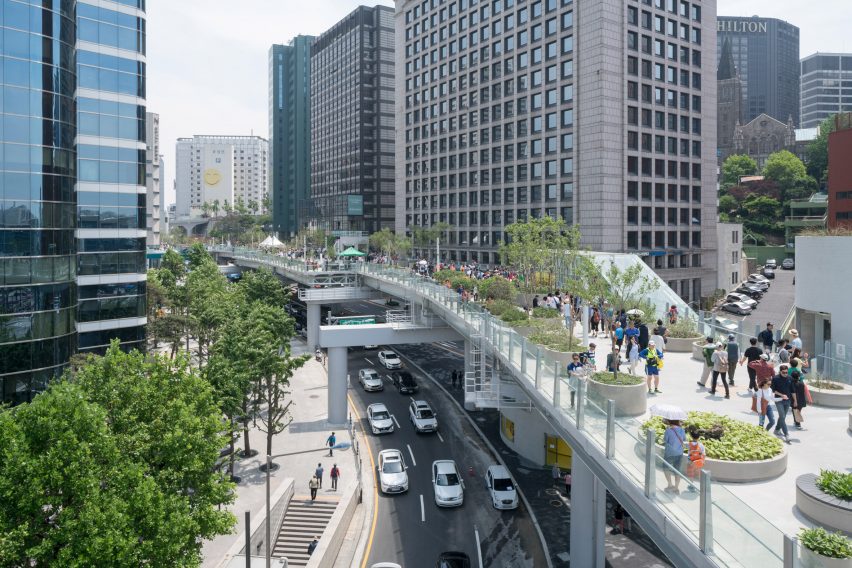Eindhoven pioneers use of scent and light to "influence the behaviour of people" in crowds
Scent and coloured lights could be used to reduce aggression in city streets, according to a crowd-behaviour expert who spoke at Dezeen's talk about design and terrorism at Dutch Design Week 2017.
LED lamps that can be varied in colour and intensity are already being used in a busy nightlife district in Eindhoven, and the Dutch city is now experimenting with mood-changing aromas that could calm agitated crowds.
"We are starting to use smell to see how we can influence the behaviour of people," said Tinus Kanters, project manager at the Dutch Institute for Technology, Safety and Security.
Speaking at Dezeen's Good Design for a Bad World talks series in Eindhoven in October, Kanters said that trials had already shown the calming affect aromas can have on individuals.
"We did some tests with the smell of oranges with people who were arrested," he said. "You can see that people who are arrested took less medicines to calm down. So you can see that it influenced [their] state of mind."
Using light to change the behaviour of crowds
Kanters is involved in Stratumseind Living Lab, a project investigating ways of improving public safety in Stratumseind, a 250-metre-long street lined with bars and clubs in Eindhoven.
The project, a collaboration between Dutch electronics brand Philips and the Intelligent Lighting Institute at Technical University Eindhoven, is believed to be the first of its kind in the world.

"We try to influence the behaviour of people using light," said Kanters. "We are sure that light can influence behaviour."
The street, which attracts up to 15,000 people on weekend nights, is monitored by sensors and cameras mounted along its length. Aggregated data on visitor numbers, noise levels, social media activity and other variables including the weather are processed to predict when the mood might turn ugly.
"We try to have less aggression and more atmosphere on the street," Kanters said. "We have technical sensors to detect aggression and we can in a split second tell if there is any aggression."

LED luminaires fitted on lamp posts with variable intensity, colour, direction and movement are then used to attempt to calm the crowd. This is done by using light to create better self-awareness and peer monitoring among revellers.
"If you have a lot of people together and they watch after each other then you will get more energy out of the group and more safety within the group," Kanters said.
Smell "goes directly into your brains"
Smell could prove to be an even more powerful crowd-control tool than light, Kanters said.
"With light and noise you have a built in filter; you can get used to it," he said. "For instance if you live near to a train station then the trains won't bother you anymore after some days. But smell it goes directly into your brains."

Kanters' team also uses technology to look out for potential terrorist activity. "We also have video captioning systems and systems that can look at for instance [whether] a truck is driving too hard through the centre of Eindhoven. I don't believe in putting everything behind concrete barriers, I think that we have to find a way to have sensors like these."
Kanters rejected the notion, raised by the deputy mayor of Paris last year, that robot barriers could be deployed in cities to prevent vehicle-based terrorist attacks.
"Developing technology costs a lot of money. So if you want to have automatic bollards in every street it's gonna cost you millions and millions and millions," Kanters said. "It's not possible to protect a city with that kind of technology."
Data can help predict and prevent terrorist attacks
Instead of reacting to unfolding attacks, cities should invest in technologies that spot potential threats before they occur, he said: "Data can give you more information and cheaper than deploying physical blocks."
"Technology could be part of the conversation but if you think about the latest terror attacks in Europe for instance they were done with very basic means," said Rotterdam-based architect Marina Otero Verzier, another speaker on the panel.
"Actually what triggers more fear is to know that something very basic that you see every day can be deployed against you as an act of terror," she said, referring to the recent spate of attacks using vehicles.
"I don't see that technology is the only solution," added Otero Verzier, who is head of research and development at architecture and design research institute Het Nieuw Instituut. "My concern about security is that is really challenging and putting pressure on our rights whereas a real impact is questionable."
Designers can help make cities less prone to attack
She added that designers had a key role to play in making cities less susceptible to attack: "As designers we also have the expertise to analyse a city in terms of many different terms. One is circulation. We understand flows of people, we know where the places are most likely to have a terrorist attack and so I think there are many ways in which we can offer our expertise to think about how to make safer cities."
Architect Winy Maas of MVRDV said that considering terrorist acts had become an issue which extents the normal safety elements that we need to deal with."
He recounted his experience of working on Seoullo 7017, a kilometre-long elevated road in Seoul that has been converted into a park. Security was of paramount concern, he said, and sophisticated monitoring systems are in place to ensure public safety.
"It has led to, I think for me the first and biggest war room I've ever made in my life with 25 security people every night with cameras on every spot, with sensors on every spot," he said.

German novelist Ingo Niermann argued that the lack of sophistication of many recent terrorist attacks was a cause for optimism.
"I have the impression that most terrorist attacks really in the last years have not been executed with a lot of intelligence," he said. "That is quite amazing so we can be really happy."
Social media exaggerates the risk of terrorist attacks
Kanters pointed out that terrorists are claiming fewer lives today than in the past, but digital media was helping to stoke public fear.
"If you look at the yearly figures for the last 20 or 30 years about the amount of people getting killed by terrorist attacks, then these years are more safe than the 1980s and 1990s that's for sure," he said. "It's a big psychological thing to think that we are in a difficult environment. It's more safe but the things that happen come very fast with social media and everything."
"So if everybody's calling for more security then you have to look at the other side: it will cost you privacy, it will cost you your way of life."
Designers can help mediate this discussion, he said: "I think designers can point out where privacy is absolutely necessary for safety and security because that isn't being done by the police or governments."
The design and terrorism debate was one of five Good Design for a Bad World talks that Dezeen hosted during Dutch Design Week
Dezeen hosted five talks during this year's edition of Dutch Design Week, covering a range of global issues including politics and refugees.
Movies of all of the talks, including this one, are available to watch in full via our Good Design for a Bad World page. Edited version of the and the refugee talk are also available, and the remaining two will be published soon.
